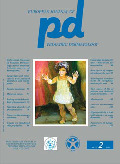Hypersensitivity to Anisakis simplex in pediatric patients with atopic dermatitis.
Downloads
How to Cite
Cadoni S., Lavieri M.M., Ruffelli M., Biondi M., Paradisi M., De Pità O. 2008. Hypersensitivity to Anisakis simplex in pediatric patients with atopic dermatitis. Eur. J. Pediat. Dermatol. 18 (2):109-12.
pp. 109-112
Abstract
Anisakis simplex (AS) is a nematode parasite of fishes, crustaceans and cephalopods, that may cause IgE mediated reaction after the ingestion of raw or undercooked parasitized fish. Humans acquire the larvae by eating raw or undercooked seafood or cephalopods infected with the third stage larvae of AS. We performed a retrospective study on 865 pediatric patients with AD, admitted to our Institute in a period running from January 2004 to June 2007. Among 865 children with AD, we detected specific IgE to inhalant and food allergens in 521 subjects (60%). Of these patients just 52 (9.9%) presented specific IgE to AS; 8/52 (15.3%) were mono-sensitized and 44/52 (84.6%) were polysensitized. Our data show that also sensitization to AS, together to the classically involved allergens (egg, milk, fish, and so on), should be considered in case of exacerbation of dermatitis after eating fish, though it is not a frequent allergen in this pathology.Keywords
Anisakis simplex, atopic dermatitis, Allergy, Dust mites, Cross reactivity

